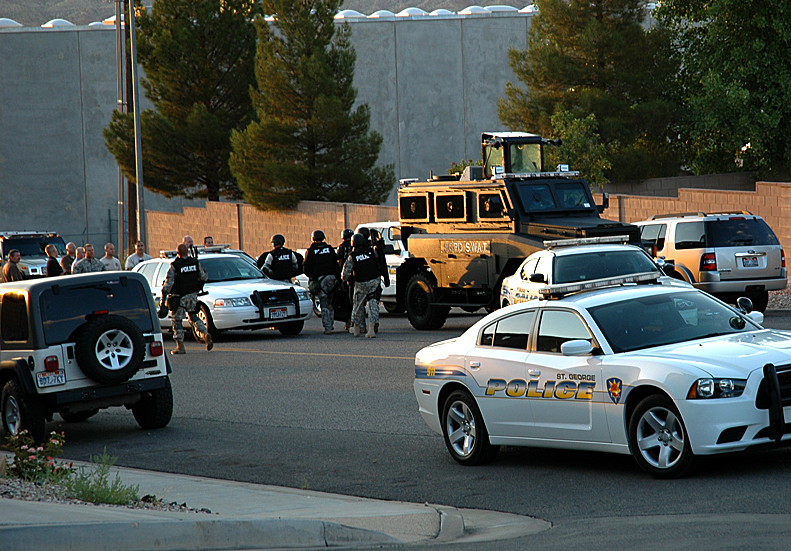OPINION – It can be very difficult these days to have a productive discussion about law enforcement in America. It has become one of the more highly polarized topics in a society where nuance has gone out of style.

The gradual shift within law enforcement hierarchy from training peace officers to training warrior cops has been underway for decades now. The so-called war on terror has served to speed up the process considerably at every level.
Somewhere in between the violent anti-police rhetoric of groups like Black Lives Matter and the reflexive near-worship of police as symbols of the state’s power is a rational middle ground.
Finding that middle ground is difficult when legitimate questions of how state power is being exercised are conflated with a murderous desire to harm anyone wearing a badge.
Recently I had the opportunity to view a documentary that manages to address a number of the real-world consequences of police militarization without devolving into an angry screed against all cops.
The film is called “Do Not Resist,” and its power in communicating the reality of the warrior cop versus the peace officer comes from its brilliant understated approach. There is no voice-over or narration to editorialize about what the viewer is seeing.
It makes its points almost entirely through the words of the officers, officials and trainers themselves. The closest thing I could see to editorializing was the dramatic tone of the film’s musical score in one or two places.
See the film trailer included in the media player top of this opinion column.
The film covers a number of aspects of modern policing, including training, SWAT raids, riot control, surveillance and procurement of military hardware.

In one memorable segment, the filmmakers take us to a storage yard when hundreds of mine-resistant, ambush-protected, or armored-patrol, vehicles are waiting to be donated to police departments by the Department of Defense.
An official from the storage yard talks about the amount of training our soldiers receive before being allowed to operate the MRAPs. He then notes that most police departments who are recipients of these armored vehicles and other hardware under the federal government’s 1033 program don’t receive this training.
They have to learn how to drive the 25-ton vehicles for themselves.
At the storage yard, an official jokes about how there shouldn’t be any body parts left in the MRAPs, quickly clarifying that, after all, they are war vehicles.
The viewer is then taken along for the ride as a small-town sheriff in Wisconsin goes for a drive in his newly acquired MRAP. The contrast of a combat vehicle driving through quiet residential neighborhoods filled with kids toys and backyard play sets is thought provoking, at the very least.
One of the most instructive segments of “Do Not Resist” comes when the filmmakers are allowed to go along for a SWAT raid with a sheriff’s office in South Carolina. This is perhaps the most instructive moment of the film.
The SWAT briefing begins with the team being informed that the specific house is being targeted for distribution of illegal drugs. They are told that there will not likely be any children present.
Upon arriving at the targeted home, officers quickly take down a couple of individuals in the yard at gunpoint while others simultaneously smash the home’s side windows and front door. There are children present, but the officers are unable to find the drugs they were told would be there.
Their frustration grows as their search drags on until eventually, less than a gram of loose marijuana residue is found in the bottom of a young man’s book bag. The young man is arrested for simple possession and is bailed out that evening.

At one point he gives the officer supervising the raid nearly $1,000 in cash that was intended to purchase lawn mowers and a weed eater for his small lawn care business. The young man asks the officer to give the money to his employee to purchase the lawn tools, but instead it is seized under asset forfeiture laws as possibly being connected to drugs.
In the meantime, the young man’s father asks the officers who will pay for the windows that were smashed during the SWAT raid. He is informed this is just part of the officers’ job and that they have no responsibility to fix what they broke.
The most powerful and disquieting aspect of this segment is how utterly mundane this raid is to the officers who are carrying it out. They clearly aren’t evil monsters bent on destruction, yet the overkill and violence of what they are doing to this family appears entirely lost on them.
All this over a few flakes of a naturally occurring plant.
Whether this is an appropriate use of state power in pursuit of justice is left to the viewer to decide, but anyone with a molecule of empathy should have some questions after seeing it.
I sincerely wish I could share this film with my friends who are police officers. Many of them have voiced similar concerns to me as those covered in this film. I wonder what their take might be.
Perhaps it could be the starting point for a productive discussion.
Bryan Hyde is a news commentator, radio host and opinion columnist in Southern Utah. The opinions stated in this article are his and not representative of St. George News.
Email: [email protected]
Twitter: @youcancallmebry
Copyright St. George News, SaintGeorgeUtah.com LLC, 2016, all rights reserved.